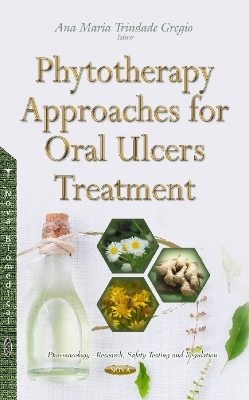Phytotherapy Approaches for Treatment of Mouth Ulcers is a book with updated and illustrated text with pictures and graphs that help to define, characterise and classify mouth ulcers. The most frequent oral mucosa lesions are the aphthous ulcerations with a prevalence of 4.6 to 30.6%. These can be defined as a fundamental lesion characterised by the absence of the epithelial tissue layer, which makes the subjacent conjunctive tissue unprotected and vulnerable to external aggressions. There are three main forms, the most common being the aphthous; these are small, rounded, defined ulcerations that are painful and heal in 10 to 14 days. The other form of recurrent aphthous ulceration is the type of deep, long aphthous that present a grayish yellow aspect, with the same period of duration and the patient frequently presents monthly lesions. They are also called herpetiform aphthous. A third form of recurrent aphthous ulceration are those distributed on the tongue dorsum; these are oral mucosa, but they are not located in the keratinised region. The mouth ulcer healing process is very complex, being characterised by taking out the conned tissue, and replaced by a conjunctive tissue. The standard healing process can be divided into three stages: (1) inflamed stage; (2) proliferative stage of fibroblasts and blood vase; and (3) maturing stage and collagen remodeling. All of these forms cause pain, discomfort and debilitate the patient, because it makes eating difficult and aggravates the clinical condition of inflammation. The exact reason for the appearance of these lesions remains obscure, but it may be affirmed that the contact of the oral mucosa tissues with physical agents capable of inducing trauma such as the edges of teeth, fractured crowns or defected restorations and maladapted orthodontic and prosthetic appliances or even the ingestion of acidic foods represent the main causes. Any medicinal strategy which anticipate or promote a closer remodeling to the physiological one is certainly desirable, because it would collaborate to reduce the discomfort and risk of later infection. The form of treatment indicated can vary depending on the professional and the period of the inflammatory cycle, and as therapy, antimicrobial compounds (terramycin, neomycin), non-steroid anti-inflammatory (derived from propionic acid), and steroid anti-inflammatory (triamcinolone -Oncilom-A (R)) agents may be used. Nevertheless, many patients that come to the dental offices with aphthous and stomatitis seek natural treatment for these afflictions. However, since the studies in this area are still at the developmental stage, an approach to prescription, posology and pharmacokinetics of these medicinal plants is needed, and this has led pharmacology, pharmacognosis, phytochemistry and microbiology entities to invest in research of new drugs with active principals of natural origin. Due to the importance of medicinal plants, studies about medicinal plants have been increased. Our objective in this book is to verify the classification, diagnosis, causes and treatment of mouth ulcers. Also, the anti-inflammatory and healing activity of Arnica montana, Chamomille recutita, and Zingiber oficinalle on the treatment of ulcer lesions, as well as observing the development of the repair process, are included. Furthermore, we have prepared a description about Traditional Chinese Medicine and mouth ulcer treatment.
Ana Maria Trindade Gregio, BPharm, MSc, PhD, at UNICAMP, Campinas, Brazil, Full Professor at PUCPR/ Brazil. Currently doing a post-doctoral studies at The University of Toledo, Toledo Ohio, US. She is a Full Professor of the Pharmacology in the Dentistry College at PUCPR. Her post-PhD, is regarding BZD action on parotid gland and signalising of proteins on the hyposalivation. She has 68 papers and 6 chapters, and now is preparing a Book; about mouth ulcer and treatment. Furthermore, she has 2 patents, one of them is about Dry mouth: Treatment of hypossalivation with Pilocarpine, another: Bixin (medicinal plants) on repair process in mouth ulcer.
For Complete Table of Contents, please visit our website at: https://www.novapublishers.com/catalog/product_info.php?products_id=57427



